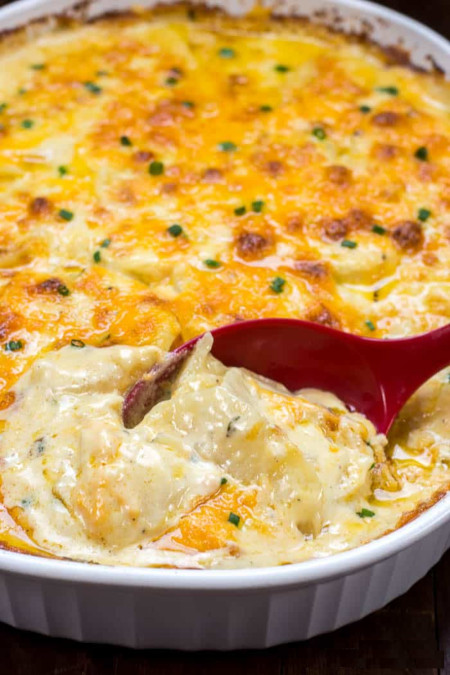I was at the hair dresser’s getting my ‘once in a while’ colour touchup not long ago and the operator at the next station over – everyone there knows I’m a Chef – asked me if I had a secret for making Scalloped Potatoes that aren’t runny. I said, I’ve never made runny Scalloped Potatoes in my life!
 Her recipe calls for layering Potato Slices and Onion Slices in a greased casserole dish, sprinkling each layer with Flour, Salt and Pepper, and small globs of Melted Butter, and pouring room temperature or warmed Milk over the whole thing up to the level of the last layer of Spuds and Onions. An hour at 375 F and they’re done. But she found she was always playing Sauce Roulette: sometimes her Scalloped Potatoes came out great, others they came out watery, as if the Milk hadn’t evaporated at all.
Her recipe calls for layering Potato Slices and Onion Slices in a greased casserole dish, sprinkling each layer with Flour, Salt and Pepper, and small globs of Melted Butter, and pouring room temperature or warmed Milk over the whole thing up to the level of the last layer of Spuds and Onions. An hour at 375 F and they’re done. But she found she was always playing Sauce Roulette: sometimes her Scalloped Potatoes came out great, others they came out watery, as if the Milk hadn’t evaporated at all.
Diagnosis
The first thing I noted about her recipe was that she wasn’t mentioning specific quantities or proportions – especially of Flour and Milk, which are supposed to go together to form the Sauce. She seemed unaware that the Butter also played a crucial role in the formation of a smooth, creamy Sauce in your Scalloped Spuds dish, helping to keep the Flour from clumping.
A brief lesson
I explained the mechanics of a beautiful, creamy Béchamel (White) Sauce to her, emphasizing the need to observe the proper proportions of Butter (or Oil, or other Fat) and Flour when making the ‘Roux’ Sauce Base. The rule is, equal parts Flour and Fat by weight. Then I imparted what may be the most important part of the Béchamel recipe: a few tablespoons of Roux go a long way to thickening a Sauce. In practice, you make a light Roux (thinner consistency) for light, thin, easily pourable sauces, and a heavy Roux for thicker, ‘tighter’ Sauces like the kind you’d use to smother Broccoli or Cauliflower, a Green Bean Casserole or other concoctions calling for ooey-gooey goodness. A thick, rich Béchamel can, in fact, be used as the binder of any Casserole that needs a creamy base. Just Season and Flavour appropriately. Classic Tuna And Noodles comes to mind.
It’s a system
Regular Pan Gravy provides a good example of how the Fat-Flour-Liquid system works. I asked how she makes her Gravy. She said she pours off some of the excess Fat first. I said that was good, because you need some Fat in there to make the Gravy work. Then, she said, she just sprinkles in Flour stirring continuously to make sure the Gravy doesn’t go lumpy. Even so, she confessed, her Gravy does go lumpy sometimes. Again, she was playing ‘Roux-lette’, because she was not aware of the rules for making a Starch-thickened Sauce.
It’s easy to avoid lumps when making Gravy by mixing a couple of tablespoons of Flour in some cold Water or Milk and pouring that into the pan drippings while stirring and simmering. If the Flour is already suspended in liquid, it won’t clump together. The mixture of cold Liquid and Flour is officially called a slurry. Easy-peasy. But you have to know the secret!
And remember: You can use a variety of Liquids to make a Béchamel Sauce. Use Chicken Stock when making a Sauce for a Chicken or Turkey Dinner side dish. I’ve used a mixture of Wine and Stock on occasion. Use your imagination!
Scalloped Spuds My Way
For Scalloped Potatoes, I’ve found the easiest way to proceed is to make a fairly large batch of standard Béchamel Sauce. Salt and Pepper to taste, and add other flavours that strike your fancy. I sometimes stir in some Rosemary (a little goes a long way) a pinch of Basil or some chopped Chives depending on what I’m serving as the main. Make the Sauce to a medium thickness if you are planning to add Cheese (which I always do!) so that the Cheese doesn’t make it tighten up too much, or go right ahead and use more Flour and mix it up Thick and Rich, if you just want the straight, unadulterated flavour of the Potatoes and Butter.
How do you gauge the proportion of Roux to liquid when making a Starch-thickened Sauce? Practice makes perfect. If it comes out too thin, just add more Roux or some Slurry. If it comes out too thick, add more of the liquid you’re using in the Sauce. You’ll soon get the hang of exactly how much of each ingredient to use to achieve your desired result.
More than just Scalloped Potatoes
Your beautiful, thick Cheesy Béchamel Sauce can be poured over cooked Pasta to make a quick, easy, creamy Mac And Cheese. Add even more Cheese plus some freshly chopped Jalapeños and you’ll get a Queso (Nacho Sauce) worthy of a Tex Mex Master Chef. And you can whip it up as a quick substitute for Hollandaise Sauce for Eggs Benedict, or other Sandwiches and Melts that get the Sauce treatment. Just add a pinch of Dry Mustard, and a pinch of Cayenne Pepper…
~ Maggie J.

